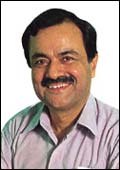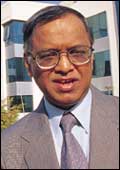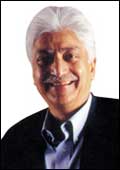 |
BILL GATES
If Microsoft tops the image charts, attribute it to Gates |
THE GATES EFFECT
Surprised that Microsoft scores over
the likes of Wipro, Infosys, Reliance Industries, Reliance Infocomm,
and Maruti in terms of image scores? Well, you shouldn't be. The
company's visibility and image points can be traced back to one
man: Chairman Bill Gates. In November 2002, Gates made a four-day
visit to the country. He met with policy makers, shuttled from one
high-profile function to another across four Indian cities (Delhi,
Mumbai, Hyderabad, and Bangalore) in his Global Express jet, pressed
the flesh with CEOs like Mukesh Ambani, Azim Premji, and N.R. Narayana
Murthy, addressed large groups of coders in Bangalore and opinion
makers in Delhi, announced an investment of $400 million in the
country, and a corpus of $100 million for the Bill & Melinda
Gates Foundation's local arm that would fight aids, and flew off
into the sunset. Not surprisingly, that got reams of press, mostly
good, including a cover story in this magazine. Still surprised?
 |
JAGDISH KHATTAR
MD Jagdish Khattar has reason to smile: Look at Maruti's
QoE. |
SMALL (CAR) WONDER
It wasn't outstanding profits, or
a super-successful product launch, or significant gains in marketshare
that ensured that the bulk of the coverage Maruti Udyog Limited
received was positive. It was a successful Initial Public Offering.
First, the IPO had trouble finding underwriters, then, the competition
upped a gear and went to town about how Maruti was losing ground
in the car market. Not too many analysts gave the company's sale
of 79.4 million shares much chance. Eventually, Maruti proved everyone
wrong. The IPO was oversubscribed three hours after it opened. Eventually,
the issue was oversubscribed 10 times. Even better, it listed at
a premium of 25 per cent of its issue price of Rs 125 on Bombay
Stock Exchange and by the end of the first trading day, some 51
million shares, nearly 65 per cent of the issue size, had been traded.
At the time this article went to press, the scrip was trading in
the Rs 360-levels, an indication that Day 1 hadn't been an aberration
wrought by irrational exuberance.
GLOSSARY/METHODOLOGY
Visibility Score: This is a function of the size of the
article, its position in the publication (cover story, first page,
etc), and the readership of the publication.
Image Score: Visibility scores for each article are multiplied
by 1, 2, or -1 depending on whether the article is neutral, positive,
or negative.
Quality of Exposure: This determines the relationship between
visibility score and image score. Mathematically, it is the image
score divided by the visibility score expressed as a percentage.
Thus, a QoE of around 100 per cent indicates that the coverage has
been largely neutral, a score significantly higher than 100 per
cent that the coverage has been largely positive, and that significantly
lower than 100 per cent that the coverage has been largely negative.
Categories: The scores are pigeonholed across various industries
(banking, consumer durables, automotive, telecom, etc).
Genres: The scores are pigeonholed across various genres
(marketing and sales, finance and financial results, corporate,
product launches, personalities, etc).
Coverage: English and vernacular newspapers. And English
and vernacular magazines. Unlike the coverage of politics, sports
or entertainment, that of business is still dominated by the print
medium.
Time Period: November 1, 2002, to October 31, 2003.
COKE INDIA
ANNUS HORRIBILIS FOR COKE
 |
SANJI GUPTA
President, Coca-Cola India |
If there is one thing about this survey
that makes Coca-Cola India happy (or so we think; the company refused
to comment on the findings), it must be the timing. The survey covers
all articles that appeared between November 1, 2002 and October
31, 2003. Consequently, all coverage related to the you-call-it-sexual-harassment,
we-call-it-contract-dispute incident involving Coca-Cola India,
its marketing chief Shripad Nadkarni, and former Miss Universe Sushmita
Sen, is excluded.
Despite that, it has been a lousy year for the world's best-known
brand in India, this despite the hosannas its advertising, created
by McCann wunderkind Prasoon Joshi and featuring actor Aamir Khan
has received. Why? Blame it on a lady called Sunita Narain, and
her organisation, Centre for Science and Environment (CSE). In February,
the Non-Governmental Organisation (NGO) came out with a report that
showed that most bottled water sold in the country (including ones
sold by Coca-Cola and Pepsi) weren't exactly uncontaminated. In
July, it followed up with another study that most soft beverages
sold in India (including almost all Coca-Cola and Pepsi brands)
had unacceptably high residues of pesticides. And coming as it did,
in the wake of a BBC report about a controversy involving a Coca-Cola
plant in Kerala and whether or not it was releasing toxic effluents
into the environment, it didn't do the company's image any good.
Coca-Cola's initial response was to badmouth the test and the
laboratory where it was carried out. And there were veiled references
to CSE's motivations, even the applicability of EC norms to India.
President Sanjiv Gupta did the rounds of the television channels.
The company's full frontal attack backfired. What should Coca-Cola
have done? Well, rival Pepsi adopted a different approach (See The
Pepsi Strategy) and that seems to have helped a bit. And B-schools
routinely roll out the Tylenol case as an example of how companies
could handle crises. In 1982, an innovative serial killer laced
certain bottles of Johnson & Johnson's pain-reliever Tylenol
with cyanide. The company's then CEO James Burke went on network
television, J&J ran ads in the papers, and it withdrew all Tylenol
bottles across the US, an exercise that set it back $100 million.
Expectedly, when new Tylenol was launched with tamper-proof packaging,
it proved a bestseller. Should Coca-Cola India have done something
different? Its scores indicate it should.
-Kushan Mitra
FMCG FLAME
Thanks to Coca-Cola, Pepsi, and,
to a lesser extent, circumstances surrounding the exit of Britannia
CEO Sunil Alagh, the FMCG sector didn't receive very good press
last year. With most large companies in the business struggling
to grow their revenues, the sector's Quality of Exposure suffered.
 |
RAJEEV BAKSHI
Chairman, Pepsico Holdings |
At just around 100 per cent, the companies would have probably
preferred not having been written about in the first place.
THE PEPSI STRATEGY
It wasn't involved in a pollution
controversy, but like Coca-Cola, Pepsi was at the receiving end
of CSE's exposes on bottled water and soft beverages. Expectedly,
the company's Quality of Exposure isn't very different from Coca-Cola's:
it stands at 70.24 per cent, just around half a percentage point
higher than Coca-Cola's. Still, Pepsi may have benefited from lower
visibility and image scores. Put simply, it didn't get written about
as much as Coca-Cola. Attribute that to the latter's standing, along
with McDonald's, as a symbol of the American way of life. And credit
Pepsi for its let's-lie-low strategy. That seems to have eased the
pain some.
 |
 |
N.R. NARAYANA
MURTHY
Chairman, Infosys (Left) and AZIM PREMJI
Chairman, Wipro |
TECH'S GLIMMER TWINS
The personality score is based on the coverage of a company driven
by personalities. Although Infosys CEO Nandan Nilekani and Wipro
Vice Chairman Vivek Paul are quite high- profile, there can be no
debating the fact that the chairmen of the two companies are responsible
for a sizable chunk of the score. It may come as a surprise to most
people that Infosys' honchos, while topping in terms of both image
score visibility score, actually trail the likes of Deepak Parekh,
Wipro's Premji and Paul, and HSBC's Niall S.K. Booker and Naina
Lal Kidwai. That can be ascribed to the not-so-complimentary coverage
the company, and its Chairman and CEO received in the wake of a
poor quarter (January-March 2003), and in the wake of its settlement
with Reka Maximovitch, who had filed a sexual harassment suit against
Infosys and its former global head of sales and marketing, Phaneesh
Murthy. Indeed, for some time in the past 12 months, it became fashionable
to knock Infosys. Then, that's a problem any company that receives
good press for 10 years running has to face sometime.
THE SMARTEST OF THEM ALL
 |
DEEPAK PAREKH
Chairman, HDFC |
Last year, he got more press than
the Ambanis and Ratan Tata, but just around a third what Infosys'
N.R. Narayana Murthy and Nandan Nilekani, and Wipro's Azim Premji
and Vivek Paul did. But no one came even close to him in terms of
quality of exposure. At 163.24 per cent, his QoE was significantly
higher than HSBC's Niall S.K. Booker and Naina Lal Kidwai's 134.02
per cent. That means Deepak S. Parekh didn't just receive adequate
press; he received adequate good press. So, how does the 59-year-old
Chairman of the Rs 2,975-crore Housing Development and Finance Corporation
(HDFC) manage it? And what explains this popularity? One reason
could be his accessibility. Parekh returns all calls. For instance,
this writer caught him on the telephone just as he was about to
catch a flight from Delhi to Goa to attend the Confederation of
Indian Industry's two-day National Council Meet. Parekh brushes
off the news about his image. "That's probably because I talk
to too many journalists," he laughs. "Like you.'' Maybe,
but it is also a function of several other factors. Success is one:
HDFC has financed over 22 lakh homes, disbursed loans over Rs 54,000
crore, and spawned successful companies in areas such as banking,
asset management, and insurance. The fact that Parekh is considered
a thinking-CEO is another: he is on several government committees
and the boards of various companies. And his inability to say no
to acquaintances and friends, still another: although he isn't a
party animal, Parekh can be spotted at most dos where his natural
amiability sees him networking. And that, in turn, further enlarges
his circle of friends and acquaintances.
-Roshni Jayakar
THE MONOLITH SCORES
The vernacular press' business coverage
is typically dominated by issues of pressing concern to investors
and consumers, not so much corporate news or personality-based news.
That explains why BSNL-it launched a cut-price cellular service-received
a third of its coverage, Reliance (for the same reasons) and Maruti
(think IPO), a quarter of their coverage, and Coca-Cola (the pesticide
controversy), a little less than a quarter of its coverage from
the vernacular press.
EDITORIAL PREFERENCES
The editorial page of newspapers and
magazines is considered sacred. Ergo, companies that receive the
most image scores from editorials and articles carried on this page
must be doing something right. Infosys tops, but the real story
is the presence of companies that aren't part of the top 10 in terms
of overall visibility and image scores: Ranbaxy, TCS, ONGC, Standard
Chartered Bank, Tata Motors, and i-flex. TCS' presence, given its
now-impending, now-not IPO, isn't surprising. All the other companies,
however, have strong stories to tell. In Ranbaxy's case, this has
to do with research and a global generics (drugs going off patent)
business. In Standard Chartered's, it is about a successful integration
of Grindlays' Indian ops. In i-flex's case, the story concerns a
made-in-India software product; and in Tata Motors', a successful
turnaround and a global foray. The message: strong stories=good
press.
HOW TO HANDLE A CRISIS
 |
BHARAT PURI
Cadbury India's MD (Right) will be happy to know that time
heals. |
The way Cadbury's managing director
Bharat Puri sees it, the company didn't do any wrong. He's right:
it didn't. Infestation in chocolates is a rare, but not-unheard-of
problem wherever chocolates are sold in the world. Invariably, this
is the result of improper storage and handling, typically at the
level of a retailer. And like Puri pointed out during a visit to
this magazine's office not too long ago, no fast moving consumer
goods company really interacts directly with small retailers. So,
when reports of a worm infestation in Cadbury's Diary Milk surfaced,
the company first wished to verify the facts. When a few more unsubstantiated
incidents surfaced soon after and the affair threatened to snowball
out of proportion, the company launched an effort to improve storage
conditions at the retail level. And finally, Cadbury India went
to the extent of reinforcing the packaging of CDM in an effort to
reassure consumers that all was well. Some of these efforts will,
no doubt, help improve the company's QoE, as indeed, they may have
in November and December, months that fall outside the purview of
the BT-Cirrus study. However, the company's QoE for October shows
a steep plunge from its normal levels. Puri can take heart from
the fact that his company's crisis-management efforts will show
results with time. And he can (and should) take heart from the fact
that the media, as indeed consumers, forget and forgive quite easily.
Take the case of Coca-Cola India and PepsiCo. In August, their QoEs
fell to the 50 per cent level. By October Coca-Cola India's QoE
had risen to 88.28 per cent and PepsiCo's, to 91.35 per cent. With
time, Cadbury's QoE will rise as well. Thanks to Puri's efforts,
this may happen sooner, or the QoE could go up far more than it
otherwise would have.
LOOKING BEYOND NUMBERS
 |
BY SRINI BALRAM
Head/Cirrus |
The Indian corporate news olympiad
is a fascinating daily event. The morning coffee has a special appeal
or tastes insipid depending on what's being written about by the
media for that day.
A news item from a company could have a strategic or tactical
intent; finally to the end reader it has a residual image/impact
value. Traditional brands as we know them are created based on sound
product management, sharp communication strategies, and brilliant
advertising. Move away a little and look at hugely successful brands
like Infosys or Wipro or other it companies-brands that have made
India proud. What did they do? How did they create their corporate
brand with little or no advertising investment?
IT companies got out of their trenches long back and have taken
their corporate brand across the Indian seas to earn their place
under the Western sun. Soon to follow would be the companies from
the pharma sector. This is substantiated by the fact that in the
top 10 companies that were written about in the editorial pages
(the prime spot as it were), more than half were from the it sector-Infosys,
TCS, i-flex, Microsoft, and Wipro. That's saying something about
building corporate brands! The sole pharma company in that list
is Ranbaxy.
Why are sales and marketing stories so 'all consuming'? Thirty
five per cent of all the image scores belong to this genre. This
is great for the companies and their respective product brands,
but in the larger picture of a corporate brand this percentage tends
to skew the picture. For instance, corporate stories on HR practices
within an organisation, social responsibility and social projects
undertaken by an organisation do get written about, but at the end
of the day they do not go beyond 2 per cent on image scores. Isn't
there a huge opportunity here?
The quality of a company's media exposure is a critical variable.
As long as a company has high media visibility with attendant high
image, the media exposure quality for that company is supreme. But
the reality is different. Most companies have a mix of neutral,
positive, and negative stories.
It's really the proportion between these three that determines
the Quality of Exposure. Tata Motors is a good example. It isn't
among the top 10 companies in terms of image scores, but it is the
first from a Quality of Exposure perspective. A solid corporate
brand is getting better.
Can we build a corporate brand using just the vernacular? Tough
call. But a good mix with the English press can do magic for the
corporate brand. What should the mix be? A 50:50 split? As of October
30, 2003, the ratio between the vernacular and the English press
was at 20:80. Isn't that a little skewed? Maybe a move towards 40:60
would be desirable.
Cirrus is a Delhi-based monitoring agency and part
of agencyfaqs.com. Feedback to bt-cirrus@icirrus.com
|
